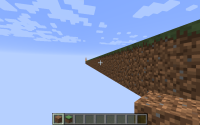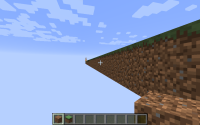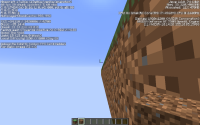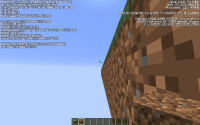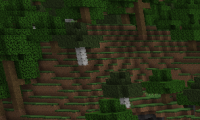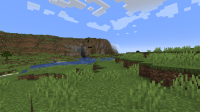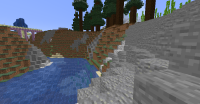-
Bug
-
Resolution: Unresolved
-
None
-
Minecraft 1.11.2, Minecraft 17w06a, Minecraft 1.13, Minecraft 1.13.1-pre1, Minecraft 1.14.2, Minecraft 1.14.3 Pre-Release 2, Minecraft 1.14.3, Minecraft 1.14.4 Pre-Release 6, 1.14.4, 1.15 Pre-release 1, 1.15.2, 1.16.1, 1.16.5, 21w10a, 1.17, 1.17.1, 21w37a, 21w38a, 21w42a, 21w43a, 1.18 Pre-release 1, 1.18 Pre-release 7, 1.18 Pre-release 8, 1.18 Release Candidate 3, 1.18, 1.18.1 Release Candidate 1, 1.18.1, 22w03a, 22w05a, 1.18.2, 22w13a, 22w15a, 22w18a, 22w19a, 1.19 Pre-release 1, 1.19 Pre-release 2, 1.19 Pre-release 3, 1.19 Pre-release 4, 1.19, 1.19.1 Pre-release 5, 1.19.1, 1.19.2, 22w44a, 22w46a, 1.19.3 Pre-release 1, 1.19.3 Pre-release 2, 1.19.3, 23w03a, 23w04a, 23w05a, 1.19.4 Pre-release 1, 1.19.4, 23w12a, 23w13a, 1.20.1, 23w33a, 24w13a, 24w14a, 1.20.6, 24w36a, 1.21.3
-
None
-
Confirmed
-
Rendering
-
Normal
-
Platform
The bug
This has been an issue for a while. It's especially noticeable at level 3 of the side of grass. See the screenshots, where I placed a row of grass on a row of dirt. With mipmaps, half of the grass block is practically black at the 'optimal' distance where the 2x2 mipmap or further is used.
How to reproduce
Open this world World.zip![]() with these settings options.txt
with these settings options.txt![]() and look straight ahead without moving.
and look straight ahead without moving.
![]() Observe the dark patches with the side of the grass.
Observe the dark patches with the side of the grass.
Proposed solution
Using Yarn mappings for 1.14.4, replace this method:
private static int blendPixels(int int_1, int int_2, int int_3, int int_4) { return SRGBAverager.average(int_1, int_2, int_3, int_4); }
using these classes provided by jonathan2520: SRGBAverager.java![]() SRGBCalculator.java
SRGBCalculator.java![]() SRGBTable.java
SRGBTable.java![]()
Original analysis
I've looked it up in MCP 9.30/9.31 (corresponding to Minecraft 1.10.2). In net.minecraft.client.renderer.texture.TextureUtil, generateMipmapData is responsible for mipmap generation. It turns out not to use proper weighting by the alpha channel. Anything that isn't fully transparent is given the full weight, and anything that is is treated as black. That's where the darkness comes from.
The correct model is most natural when using colors premultiplied by alpha: just average everything. If you don't use premultiplied colors, you must multiply colors by alpha before averaging and divide the resulting color by the resulting alpha afterward.
Premultiplied also has the advantage that any blending steps you don't control directly work correctly, like texture filtering and frame buffer blending. Minecraft won't really experience either the advantages or the disadvantages, but it's the cleaner model that would've prevented problems like this bug from the start. That's something to consider.
Adding to the problem is that Minecraft tries to apply gamma correction to the alpha channel. That blows up the opacity, only emphasizing exactly those texels that are too dark. Gamma correction of the alpha channel doesn't make sense anyway because colors can deviate either way depending on what's blended with what. The general standard—which is also what you'll get natively if you enable frame buffer and texture sRGB—is to use sRGB (which is a little more involved than x^2.2) for colors and keep the alpha channel linear.
- is duplicated by
-
MC-145394 Block Visual Bug
- Resolved
-
MC-155702 Far away grass blocks look like they have vines on the side, if viewed almost parallel
- Resolved
-
MC-176520 Mipmapping in 1.14 and 1.15 is Messed Up
- Resolved
-
MC-226260 Grass & Snow doesn't play nicely with mip-mapping
- Resolved
-
MC-230457 Grass Block Bug
- Resolved
-
MC-259491 Mipmapping causes some block faces to become too dark again in 1.19.3
- Resolved
-
MC-270166 the grass was look like savanna, but in taiga
- Resolved
-
MC-272611 Grass Blocks have a weird graphical glitch
- Resolved
- relates to
-
MC-195505 Short grass is unaffected by mipmap levels
- Reopened
-
MC-218609 Mipmapping causes some block faces to become too dark
- Resolved
